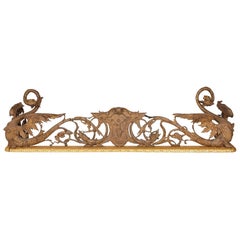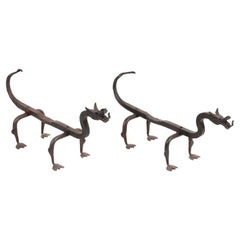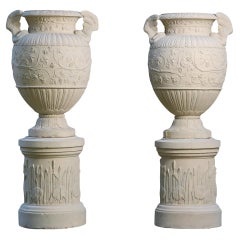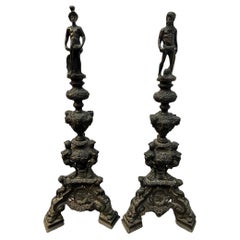Revival Building and Garden Elements
to
73
234
231
466
18
3
Height
to
Width
to
3,002
2,183
1,582
1,370
966
832
825
813
521
498
470
314
301
249
155
142
141
125
14
282
170
21
66
40
26
13
1
11
5
2
7
5
10
3
248
143
132
107
94
371
120
99
89
76
487
474
475
5
3
2
2
2
Style: Revival
Silvered and Gilt Bronze Antique French Fireplace Fender in the Neo-Gothic Style
Located in London, GB
This stunning antique French fireplace is unusual for its stylistic fusion, which combines motifs from a range of different design periods.
Most striking are the neo-Gothic depict...
Category
19th Century French Antique Revival Building and Garden Elements
Materials
Bronze
Pair of Vintage Hand Forged Wrought Iron Dragon Andirons from France
Located in San Francisco, CA
Uniquely French, these wrought iron "fire dragons" are great as decor in your fireplace, with or without the burning flames. With today's eclectic and layered interiors, the Gothic d...
Category
Early 20th Century French Revival Building and Garden Elements
Materials
Wrought Iron
Monumental Rare English Coade Stone 19th century Urns on Pedestals
Located in Katonah, NY
An exceptional pair of stoneware urns by the Coade manufactory of Lambeth (London), the body of each semi-lobed, amphora-shaped vessel ornamented with grape vines, the foot of each w...
Category
1840s English Antique Revival Building and Garden Elements
Materials
Stoneware
19th Century Hand Chilseled Marble Torso of a Victorian Maiden
Located in Port Jervis, NY
Fabulous clothed torso of a fair maiden from the victorian era
Two pieces, has a plinth base which is separate from the figure. Well worn as it has lived it's life in a garden. Str...
Category
1880s Italian Antique Revival Building and Garden Elements
Materials
Carrara Marble
$2,316 Sale Price / set
20% Off
A Large Antique Gothic Wrought Iron Fire Grate
Located in London, GB
A large and impressive Gothic Revival fire grate in wrought iron with brick fire back. The front supports swept out on splayed feet with curved elongated uprights with dragons heads ...
Category
Mid-19th Century English Antique Revival Building and Garden Elements
Materials
Wrought Iron
Pair of Antique French 19th Century Bronze Figural Chenets, Andirons
Located in Stamford, CT
Pair of antique French 19th Century Baroque style bronze figural chenets ( Andirons ). Each chenet topped with a male figure one with a helmet and the other with a beard. The bases h...
Category
Late 19th Century French Antique Revival Building and Garden Elements
Materials
Bronze
$14,000 Sale Price
20% Off
19th Century Bronze Gilded Fire Mantel Andirons Signed Didier Renaissance Style
Located in Casteren, Noord-Brabant
Beautiful set of fireplace andirons, dating from the end of the 19th century. They are made of bronze, cold gilded, in Renaissance style with lavish decorations. The size is adjustab...
Category
1880s French Antique Revival Building and Garden Elements
Materials
Bronze
Solid Wood Panel in White and Ebony Finishing with Lalique Glass, Custom Made
By Alexander's Collection, Alexander Anisimov
Located in Hong Kong, HK
Solid Wood Panel in White and Ebony Finishing with Lalique Glass, Custom Made
Made of solid wood, painted, hand carved floral elements fixed on the panel by ...
Category
2010s Hong Kong Revival Building and Garden Elements
Materials
Plywood, Wood, Art Glass, Paint, Ebony, Mirror
$10,600 Sale Price / item
20% Off
19th Century Rococo Revival Putti Wall Brackets made of Plaster, Set of 2
Located in Dusseldorf, DE
A 19th-century unique pair of Rococo style consoles with putti heads. Carved from plaster and painted in polychrome.
The consoles are open from the rear and the top. Most likely th...
Category
19th Century European Antique Revival Building and Garden Elements
Materials
Plaster
Antique Architectural Wood Pedestal Plinth, 2 Available
Located in Sheffield, MA
The very rustic antique wooden column plinth, pedestal or base in the classical style can be used as side table, end table or pedestal for either...
Category
Late 19th Century American Antique Revival Building and Garden Elements
Materials
Wood
Greek Key Wrought Iron Table & Chairs by Salterini
Located in Stamford, CT
Stunning, timeless Salterini Greek key style wrought iron table and four chairs. Original aqua color now beautifully distressed. Fabric on seats is...
Category
1940s American Vintage Revival Building and Garden Elements
Materials
Wrought Iron
Custom Neoclassical Style Metal Garden Dining Table Base by BH&A
Located in Sheffield, MA
Custom made and designed by us, this table base is elegant and rustic at the same time. This wrought iron garden dining table base can be used...
Category
21st Century and Contemporary American Revival Building and Garden Elements
Materials
Iron
Armchair / Chair in Wrought Iron, Garden Furniture, Indoor and Outdoor
Located in Miami, FL
Expoxi finished
Indoor and outdoor.
Category
2010s Spanish Revival Building and Garden Elements
Materials
Wrought Iron
Pair of Fine Quality French Gothic Revival Brass Chenets
Located in London, GB
A pair of French Gothic revival brass chenets with scrolled form throughout, small flower embellishment to centre surmounted by round mulling tops. Mid 19th century.
Height: 550 mm ...
Category
Mid-19th Century French Antique Revival Building and Garden Elements
Materials
Brass
Gothic Lion’s Mask Brass Door Knocker This is a good looking door knocker
Located in Godshill, Isle of Wight
Gothic Lion’s Mask Brass Door Knocker
This is a good looking door knocker, the handsome Lion’s Head is at the centre and the outer ring strikes the sound
The door knocker is in goo...
Category
1960s Vintage Revival Building and Garden Elements
Materials
Brass
Pr. Ornate Wrought Iron Patio Garden Dining Chairs by Lee Woodard
Located in New York, NY
Pair ornate wrought iron dining chairs, with original vinyl seats. Both are in very fine, ready to use condition, retaining Lee Woodard labels. Offered and priced as a pair.
Category
Mid-20th Century American Revival Building and Garden Elements
Materials
Wrought Iron
Large Historic 19thC Carved Stone Sandstone Font Garden Fountain Feature Planter
Located in Llanbrynmair, GB
A genuine reclaimed church font from a small welsh parish in mid-wales. Dating to 1863 when St Johns Church, in the small hamlet village of Llanbrynmair, i...
Category
1860s British Antique Revival Building and Garden Elements
Materials
Sandstone
Wide Inglenook Fire Log Grate This is a Large Forged Iron Log Grate
Located in Godshill, Isle of Wight
Wide Inglenook Fire Log Grate
This is a Large Forged Iron Log Grate, it is very heavy and would look superb in an open or Inglenook fire place, the original floor of the grate ha...
Category
1890s Antique Revival Building and Garden Elements
Materials
Iron
Pair Of Renaissance Revival Bronze Andirons
Located in Essex, MA
19th century copies of renaissance examples each with lions over cartouches and bracket legs with winged caryatids. The design of these is very reminiscent of Jacque I Androuet du C...
Category
1870s Italian Antique Revival Building and Garden Elements
Materials
Bronze
$5,800 / item
19th Century Wrought and Cast Iron Illuminated Neo-Gothic Overdoor
Located in Hastings, GB
One of the most outstanding pieces of ironwork we have ever seen, truly a one off spectacular mid-19th century iron overdoor, sourced from a Scottish estate this bespoke overdoor exp...
Category
Mid-19th Century Scottish Antique Revival Building and Garden Elements
Materials
Wrought Iron
French Cast Iron Two Tiered Fountain with Cherub Baluster, Scalloped Pool
Located in Katonah, NY
A two-tier cast-iron fountain with two fountain bowls, the lower bowl larger, each bowl with scalloped edge and cherub masks on the underside, the smaller bowl surmounted by a founta...
Category
1870s French Antique Revival Building and Garden Elements
Materials
Iron
$25,600 Sale Price
20% Off
Pair of Samuel Yellin Italian Renaissance Wrought Iron Andirons
By Samuel Yellin
Located in Queens, NY
Pair of Italian Renaissance-style wrought iron andirons with an upper and lower spike & basket design with open scroll base & griffins supporting a cross bar (Attributed to SAMUEL YE...
Category
19th Century American Antique Revival Building and Garden Elements
Materials
Wrought Iron
Giallo d’Istria Wall fountain
Located in Greding, DE
Wall fountain made of Giallo d’Istria natural stone with a rectangular basin and curved back panel. Fine volutes and a central rosette detail give the simple design a classic touch a...
Category
21st Century and Contemporary Italian Revival Building and Garden Elements
Materials
Stone
Italian 19th Century Neoclassical Style Carved Carrara Marble Lion Wall Console
Located in Los Angeles, CA
A Large Italian 19th century neoclassical Revival style carved Carrara marble figural wall console table. The rectangular marble top supported by twin Roman carved marble monopodiums...
Category
19th Century Italian Antique Revival Building and Garden Elements
Materials
Carrara Marble
$19,800 Sale Price
20% Off
French Baroque Style Bistro Side Table
Located in Sheffield, MA
French marble-top on lyre style metal base side table or end table with wonderful patina.
Category
19th Century French Antique Revival Building and Garden Elements
Materials
Stone, Metal
Rococo Revival Brass and Iron Fireplace Andirons, French, c. 1880
Located in Ross, CA
Rococo Revival fireplace andiron set of two, made in France in the late 19th century. Made of cast brass and forged iron stems.
Category
Late 19th Century French Antique Revival Building and Garden Elements
Materials
Brass
2 Vintage Cast Iron Grecian Garden Pedestals Plinth Stand Urn Base Figures 27"
Located in Dayton, OH
Large pair of Grecian Cast Iron Plinths. Features a square tapered form with scenes of men and horses. The pedestal has a foliate freeze, herringbone trim, and sculpted moldings. ...
Category
20th Century Revival Building and Garden Elements
Materials
Iron
$4,400 Sale Price / set
20% Off
Cast Aluminum Settees by Molla & Full Embossed Pattern Cushions Pair Available
By Molla
Located in Port Jervis, NY
Fabulous pair ( priced and sold separately) of indoor outdoor patio settees by Molla. Cast Aluminum frames with embossed pattern cushions. Ball and ...
Category
1970s Italian Vintage Revival Building and Garden Elements
Materials
Aluminum
$956 Sale Price / item
20% Off
19th-Century Continental Neoclassic Faience Stove from the Iris Apfel Collection
Located in Morristown, NJ
France or Italy, 19th Century, tin-glazed terracotta, in three stacked sections with domed wooden cap, featuring raised foliate scrollwork, floral garlands, and Rococo-inspired carto...
Category
19th Century Italian Antique Revival Building and Garden Elements
Materials
Brass
18th Century Continental Terracotta Egyptian Revival Sphinxes, a Matched Pair
Located in Miami, FL
18th Century Continental Terracotta Egyptian Revival Sphinxes, a Matched Pair
Offered for sale is a rare matched pair of Continental 18th cent...
Category
18th Century European Antique Revival Building and Garden Elements
Materials
Terracotta
$6,500 Sale Price / set
63% Off
Pair of Italian Neo-Classical Style Marble Urns
Located in Sheffield, MA
A most attractive pair of Italian Neo-Classical style white Carrara marble urns. Elegant fluted bodies giving it both a clean modern and yet classical look. Marble shows aged patina...
Category
Early 20th Century Italian Revival Building and Garden Elements
Materials
Marble
$2,950 / set
Grecian Style Parcel Gilt Wall Panels, a Pair
Located in Sarasota, FL
A pair of opposing Grecian inspired carved wood parcel gilt wall panels circa 1920. Scenes depict Athena with her bow, arrows, and a spear riding a chariot pulled by two stags. Two n...
Category
1910s Unknown Vintage Revival Building and Garden Elements
Materials
Wood
$12,500 / item
Large Oak Antique Mantel with Hood from a Chateau
Located in SAINT-OUEN-SUR-SEINE, FR
This exceptional Neo-Renaissance style fireplace comes from the Péclavé castle in the town of Samazan in the Aquitaine region. The castle b...
Category
1860s French Antique Revival Building and Garden Elements
Materials
Oak
19th Century Black Gothic Antique Griffin Fire Basket
Located in London, GB
A very powerful antique cast iron Victorian black Gothic fire basket.
With Very Unique Andirons as stylized griffins with rings through their noses
an...
Category
Early 19th Century English Antique Revival Building and Garden Elements
Materials
Iron
$4,131 Sale Price
20% Off
Neo-Baroque Planter in Carved Wood Black Forest Switzerland Late 1800s
Located in Milano, IT
Black Forest planter from the late 19th century. Made of richly carved walnut wood. The four feet, like the supporting shaft, are carved in the guise of twisted branches on which ivy...
Category
Late 19th Century Swiss Antique Revival Building and Garden Elements
Materials
Nutwood
Gothic Revival Style Antique Wooden Double Leaf Door from Spain
Located in Vulpellac, Girona
Gothic Revival Style Antique Wooden Double Leaf Door from Spain. Hand carved decorations in gothic revival style with Iron door handles in Seahorse sh...
Category
Early 19th Century Spanish Antique Revival Building and Garden Elements
Materials
Wood
Pair of Ormolu Capitals in Neoclassical Style
Located in Madrid, ES
A pair of capitals that were part of some columns, in ormolu bronze, with a neoclassical decoration of Corinthian order.
Category
Late 19th Century French Antique Revival Building and Garden Elements
Materials
Ormolu
$1,002 / set
Early 19th Century Belgian Giltwood Finial, on Stand
Located in New York, NY
A hardwood polychromed architectural finial from Belgium. Circa 1800, possibly earlier.
Intricately hand-carved and decorated in typical neo-gothic fashion, the outside is finished...
Category
Early 1800s Belgian Antique Revival Building and Garden Elements
Materials
Hardwood
Pair of French 19th Century Egyptian Revival Figural Chenets by Bouhon Freres
Located in Los Angeles, CA
A fine pair of French 19th century Egyptian revival gilt and patinated bronze figural chenets by Bouhon Freres, a Paris. Each Chenet surmounted with a patinated bronze figure of a re...
Category
19th Century French Antique Revival Building and Garden Elements
Materials
Bronze
$3,985 Sale Price / set
46% Off
Pair Italian Bronze Chenets in Renaissance Style
Located in New York, NY
Pair of figural bronze andirons depicting a variety of mythological figures, including cupids, lions, rams, dragons and gargoyles.
Category
Early 20th Century Italian Revival Building and Garden Elements
Materials
Bronze
$3,500 / set
Whimsical English 19th-20th Century White Marble Figural Outdoor Dog Fountain
Located in Los Angeles, CA
A Whimsical English 19th-20th century white marble figural fountain with dogs fountain. The Baroque Revival six-sided tripod marble base surmounted with three upright seated Yorkshire Terriers resting on a leaf and acanthus center stem, topped with a semi-circular scalloped carved basin...
Category
Early 1900s English Antique Revival Building and Garden Elements
Materials
Marble
Pair of Renaissance Revival Brass Andirons
Located in Montreal, QC
These tall and well modelled fire dogs add a decorative accent in summer and a useful complement to your winter fires.
Category
19th Century English Antique Revival Building and Garden Elements
Materials
Brass, Iron
$2,400 / set
19th C Large French White Cast Iron Jardiniere
Located in Hastings, GB
Dove Grey large scale Jardiniere, dating to circa 1890-1900, deep and heavy, decorative cast iron construction, historically overpainted in an aged dove grey paint which has resulted...
Category
1880s French Antique Revival Building and Garden Elements
Materials
Iron
Set of Four 19th Century Cararra Marble Columns with Byzantine Capitals
Located in Dallas, TX
Set of four 19th century cararra marble columns with byzantine capitals are ideal for setting a special architectural framework or ballustrade, or as artworks unto themselves! Hand-c...
Category
Mid-19th Century French Antique Revival Building and Garden Elements
Materials
Carrara Marble
Antique Venetian Renaissance Marble Mantel
Located in Tyrone, Northern Ireland
The serpentine shaped frieze has incredibly fine carvings of fabulous Renaissance ornament. The centre cartouche is upheld by male figures terminating in scrolling acanthus leaf’s, these flanked by dragons amongst foliage and female figures on each of the curved corners.
The frieze upheld by highly carved baluster shaped pedestals on Rosso Verona jambs.
Made from Pietra d’Istria marble and Rosso Verona marble.
Photographed in un-restored original condition, can be cleaned if preferred,
circa 1830
Provenance: Talygarn house in Wales, rebuilt during the 19th century by George Thomas Clarke, industrialist, ironmaster for Isambard Kingdom Brunel.
Category
Early 19th Century Italian Antique Revival Building and Garden Elements
Materials
Marble
Large Cast Iron Urn, Garden Planter
Located in Godshill, Isle of Wight
Large cast iron urn, garden planter
This is a superb large garden urn on a plinth, the urn is in cast iron with a classical flower pattern and i...
Category
Early 20th Century Revival Building and Garden Elements
Materials
Iron
Pair of Patinated White Renaissance Revival Plaster Corbels
Located in Los Angeles, CA
A pair of Renaissance Revival Plaster Corbels. Both look to have been pulled from an architectural setting. Each corbel has an installed metal bracket ...
Category
20th Century Revival Building and Garden Elements
Materials
Plaster
An antique Gothic revival, black marble and portoro marble mantel
Located in Tyrone, Northern Ireland
An antique Early Victorian period Gothic revival, black marble and portoro marble fireplace
The half octagonal Nero Portoro marble columns are sat on pure black marble pilasters and ...
Category
Mid-19th Century Northern Irish Antique Revival Building and Garden Elements
Materials
Marble
Carved Marble Figure of a Faun, Inspired by the Antique Original
Located in Katonah, NY
A carved marble figure of a faun playing the flute, the figure’s head is tilted to meet the flute in playing position, with left leg crossed in front of the right leg, and with left ...
Category
1890s Italian Antique Revival Building and Garden Elements
Materials
Marble
Set of 3 Continental Steel Fire Tools
Located in Queens, NY
Set of 3 Continental (Probably German 19th Century) steel fire tools on an elaborately chased stand with a bear head finial top.
Category
19th Century European Antique Revival Building and Garden Elements
Materials
Steel
$4,800 / set
Neoclassical Alabaster Urn Lamp on Solomonic Pedestal Column
Located in Barcelona, ES
Carved Alabaster Floor Lamp.
Outstanding Neoclassical carved alabaster urn lamp with handles on column pedestal stand, Spain, 1930s-1940s
T...
Category
Early 20th Century Spanish Revival Building and Garden Elements
Materials
Alabaster
Small Neoclassical Bronze Grand Tour Gueridon-Form Plant Holder, circa 1900
Located in Lambertville, NJ
A small grand tour bronze plant holder form around 1900, in the form of an ancient Roman gueridon, in the best verdigris surface. The cast detail, including swags and jabots, caryati...
Category
Early 20th Century English Revival Building and Garden Elements
Materials
Bronze
19th Century Cast Bronze Decorative Masonry Plaque
Located in Dallas, TX
19th Century Cast Bronze Decorative Masonry Plaque was designed to be inset with a masonry wall, surround or framework to add a timeless decorative touch. Depicting a Greco-Romanesque urn bursting with flowers, it was cast from solid bronze, it is a great choice for a kitchen backsplash...
Category
Late 19th Century French Antique Revival Building and Garden Elements
Materials
Bronze
French 19th Century, Whimsical Rococo Style Marble Carved Planter with Children
Located in Los Angeles, CA
A fine French 19th century whimsical Rococo style white marble carved planter jardinière with figures of playful Putti 'Children' playing with a goats among trees and vines, raised o...
Category
19th Century French Antique Revival Building and Garden Elements
Materials
Marble
Pair French 19th Century Baroque Revival Style Steel and Bronze Chenets Andirons
Located in Los Angeles, CA
A pair of French 19th century Baroque Revival style steel and patinated bronze figural chenets (Andirons). Each with a posing male figure holding a satyr shield next to decorative sp...
Category
Early 1900s French Antique Revival Building and Garden Elements
Materials
Bronze, Steel, Iron
$4,250 Sale Price / set
34% Off
Capping Finial Newel Post Staircase Pair Oak Cup & Cover Ball 33cm 13" high
Located in BUNGAY, SUFFOLK
Rare pair of oak newel post cappings or finials
Elegant and finely turned ball supported cup sweeping into deep moulded base
Made from high quality oak ...
Category
19th Century English Antique Revival Building and Garden Elements
Materials
Oak
Set of 4 Outdoor French Painted Iron Urns
Located in Queens, NY
Set of 4 Outdoor French (19th Cent) painted iron urns with scroll handles and cover decorated with foliage and Greek key design
Category
19th Century French Antique Revival Building and Garden Elements
Materials
Iron
$45,000 / set
French Louis XV Rouge Marble Fireplace Mantel
Located in New York, NY
A distinguished and gracefully sculpted Louis XV-style fireplace mantel, originating from France circa 1850, this exquisite piece embodies the opulence and fluidity of the 19th centu...
Category
19th Century French Antique Revival Building and Garden Elements
Materials
Marble
Gothic Revival Antique Cast Iron Fire Grate
Located in Wormelow, Herefordshire
Dating from the Mid-19th Century, this English antique cast iron fire grate or brazier is over 170 years old. It is highly decorative, cast in iro...
Category
Mid-19th Century English Antique Revival Building and Garden Elements
Materials
Metal, Iron
Lovely Neo-Greek Planter Attributed to C-G Diehl, France, Circa 1870
Located in PARIS, FR
Circular plant pot with a double tray united by a black tripod attributed to C-G Diehl. Charming wood marquetry. A beautiful gilded bronze adornment complete this piece.
Arriving in...
Category
1870s French Antique Revival Building and Garden Elements
Materials
Bronze
$9,551 Sale Price
40% Off
Revival building and garden elements for sale on 1stDibs.
Find a broad range of unique Revival building and garden elements for sale on 1stDibs. Many of these items were first offered in the 21st Century and Contemporary, but contemporary artisans have continued to produce works inspired by this style. If you’re looking to add vintage building and garden elements created in this style to your space, the works available on 1stDibs include building and garden elements, decorative objects, tables and other home furnishings, frequently crafted with metal, stone and other materials. If you’re shopping for used Revival building and garden elements made in a specific country, there are Europe, France, and United Kingdom pieces for sale on 1stDibs. While there are many designers and brands associated with original building and garden elements, popular names associated with this style include Maitland Smith, Molla, Henry Hobson Richardson, and Benham & Froud. It’s true that these talented designers have at times inspired knockoffs, but our experienced specialists have partnered with only top vetted sellers to offer authentic pieces that come with a buyer protection guarantee. Prices for building and garden elements differ depending upon multiple factors, including designer, materials, construction methods, condition and provenance. On 1stDibs, the price for these items starts at $119 and tops out at $721,205 while the average work can sell for $3,495.
Recently Viewed
View AllMore Ways To Browse
Antique Cast Iron Lions Head
Bronze Water Fountains
Brownstone Furniture
Cast Iron Lady
Cast Iron Swan
Cherub Fish
Chinese Rose Garden Seat
Deck Cannon
Fountain Surrounds
Garden Etagere
Greek Oil Jar
Iron Deer
Modern Iron Gate
Spanish Carved Panel
Stone Rams
Victorian French Doors
Vintage Fireplace Poker
Wm H Jackson





